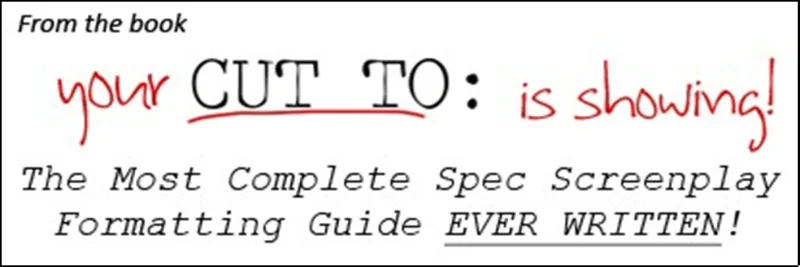
Screenwriting ABCs Script Formatting
Chapter 1 - Basic Rules for EVERY Screenplay
by T. J. Alex
Screenwriting Lesson, 2 pages
Viewed by: 41 Residents and 142 Guests

Basic Rules for EVERY Screenplay
I know, I know. You've been writing for a long time. You learned the basics of screenplay writing a LONG time ago. You don't need a refresher. Fine. That's good. But you'd be surprised just how many people out there need answers on even the simplest of questions.
I sympathize. I was once one of those people.
Here are the basic formatting rules for every screenplay:
Paper: 8 1/2" x 11" white 20 lb. Three-hole punched.
Type Font : 12 pt. Courier or Courier New, which is a 10-pitch, fixed-pitch font.
What does all that mean? Well, 12 point is the size of the font. We are all familiar with that concept. 10 pitch means that 10 characters = one inch of space on the page. Fixed pitch means that every character, whether lowercase or uppercase, will take up the same amount of space on a line. There are definitely other fonts that fit the bill. But just stick with Courier.
Margins: 1" for Right, Top, and Bottom margins. 1.5" for Left margin (to allow for holes). Right margin is NOT justified!!
Length: 85 to 120 pages, no less and no more.
Many formatting experts would argue the maximum limit is 125 pages. Lessen the chances of crossing that boundary by putting 120 pages in your head.
When I edit a screenplay, the first thing I do is check the page count. If I see 120 pages, I get nervous, because if my analysis of the script includes ADDING scenes here and there, odds are I've got to advise cutting scenes as well. Even though I say the max is 120, I prefer to see 114116 pages (about average for most screenplays) to leave a little re-writing room.
Genre often plays a large part in determining how long your screenplay should be. Animated features and kid's movies tend to be shorter in length - around 85 to 100 pages (you can keep a child's attention for only so long), while comedies, sci-fi, and horror films will be longer, around 95 to 110 pages. Thrillers and dramas are always the longest genres of screenplay, often pushing the 120-page boundary.
Recently when a client of mine sent me a 150-page screenplay, I told him to cut 30 to 40 pages. He argued that James Cameron wrote more than 120 pages with Avatar. I told my client when he helps to create the highest grossing film of all time, he can, too. Until then, cut 30 to 40 pages.
DO NOT:
• Exceed 120 pages (fastest way to get your screenplay tossed into File 13)
• Write less than 85 pages (second fastest way)
• Cheat the margins to lessen or increase the page count
• Decrease or increase font size or use a different font to lessen or increase the page count
• Use any other font other than Courier New or Courier
• Include artwork ANYWHERE in the screenplay
• Use an off-white color to appear more professional
• Number the scenes. This will be done once the screenplay is sold during the preproduction phase
• Justify the right margin
• Type CONTINUED at the bottom and top of pages. Again, this is done on sold scripts only
• Send out a script that hasn't been proofread for formatting, spelling, grammar and punctuation errors
• Send "extras" with your script, such as cast lists, character lists, character bios, budgetary estimates, or a synopsis (unless an agent or production company specifically requests a synopsis)
• Put a date anywhere on the script, or designate your script as the “First Draft,” "Second Draft," "Final Draft," or any draft. If you are sending it out to sell, it should be the finished draft
• Bold or italicize for emphasis anywhere in your script. Why? Because if the script is copied multiple times by a production house, the emphasis will eventually be lost. If you need to emphasize something, underline it
• Include a header or a footer, such as the title and author at the top of each page
• Use camera, lighting, or effects direction unless absolutely necessary. Even then, use it VERY sparingly
Why so strict?
One Screenplay Page = One Minute of Film Time (roughly) when a screenplay is properly formatted. Producers like that, as it makes budgets and shooting schedules easier to estimate. Any deviation from proper margins, font, or type size means screen time is impossible to calculate.
But there's another reason why knowing the screen time of a screenplay is important. Every theater has only so many hours a day to run a film on a screen. The shorter the film, the more times that film can be played per screen per day. The more times per day a movie runs, the more money a production company stands to make. That is pretty blunt, and easy to understand.
For a WONDERFUL discussion of film and screenplay length, read the "Foreword" written by James F. Boyle in the book The Complete Guide to Standard Script Formats by Hillis R. Cole, Jr. and Judith H. Haag.
------------------------
For more screenplay formatting rules and advice, check out the book, Your CUT TO: Is Showing! by T. J. Alex or visit www.scripttoolbox.com. From there, please like the page on Facebook, and share it with your friends.
If you have any formatting questions, please email T. J. at tj@tjalex.com.




